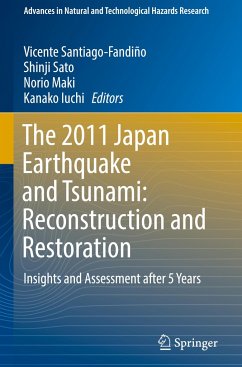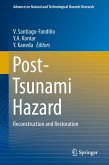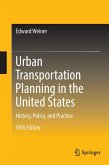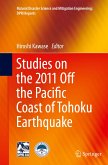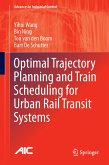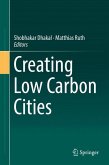The 2011 Japan Earthquake and Tsunami: Reconstruction and Restoration
Insights and Assessment after 5 Years
Herausgegeben:Santiago-Fandiño, Vicente; Sato, Shinji; Maki, Norio; Iuchi, Kanako
The 2011 Japan Earthquake and Tsunami: Reconstruction and Restoration
Insights and Assessment after 5 Years
Herausgegeben:Santiago-Fandiño, Vicente; Sato, Shinji; Maki, Norio; Iuchi, Kanako
- Gebundenes Buch
- Merkliste
- Auf die Merkliste
- Bewerten Bewerten
- Teilen
- Produkt teilen
- Produkterinnerung
- Produkterinnerung
This book covers the restoration and reconstruction process and activities undertaken in Japan in the first five years since the 2011 Earthquake and Tsunami - a period widely considered to be the most intensive reconstruction phase within the 10-year restoration plan drawn up by the Japanese Government.
The respective chapters explore technical, scientific, social and non-scientific (policy-related) aspects, including: reconstruction and restoration policies, infrastructure and designs for tsunami coastal defence, resilient urban areas and affected communities, housing and relocation…mehr
Andere Kunden interessierten sich auch für
![Post-Tsunami Hazard Post-Tsunami Hazard]() Post-Tsunami Hazard75,99 €
Post-Tsunami Hazard75,99 €![Urban Transportation Planning in the United States Urban Transportation Planning in the United States]() Edward WeinerUrban Transportation Planning in the United States119,99 €
Edward WeinerUrban Transportation Planning in the United States119,99 €![Studies on the 2011 Off the Pacific Coast of Tohoku Earthquake Studies on the 2011 Off the Pacific Coast of Tohoku Earthquake]() Studies on the 2011 Off the Pacific Coast of Tohoku Earthquake75,99 €
Studies on the 2011 Off the Pacific Coast of Tohoku Earthquake75,99 €![District Heating and Cooling Networks in the European Union District Heating and Cooling Networks in the European Union]() Antonio Colmenar-SantosDistrict Heating and Cooling Networks in the European Union67,99 €
Antonio Colmenar-SantosDistrict Heating and Cooling Networks in the European Union67,99 €![Carbon Footprint and the Industrial Life Cycle Carbon Footprint and the Industrial Life Cycle]() Carbon Footprint and the Industrial Life Cycle135,99 €
Carbon Footprint and the Industrial Life Cycle135,99 €![Optimal Trajectory Planning and Train Scheduling for Urban Rail Transit Systems Optimal Trajectory Planning and Train Scheduling for Urban Rail Transit Systems]() Yihui WangOptimal Trajectory Planning and Train Scheduling for Urban Rail Transit Systems75,99 €
Yihui WangOptimal Trajectory Planning and Train Scheduling for Urban Rail Transit Systems75,99 €![Creating Low Carbon Cities Creating Low Carbon Cities]() Creating Low Carbon Cities97,99 €
Creating Low Carbon Cities97,99 €-
-
-
This book covers the restoration and reconstruction process and activities undertaken in Japan in the first five years since the 2011 Earthquake and Tsunami - a period widely considered to be the most intensive reconstruction phase within the 10-year restoration plan drawn up by the Japanese Government.
The respective chapters explore technical, scientific, social and non-scientific (policy-related) aspects, including: reconstruction and restoration policies, infrastructure and designs for tsunami coastal defence, resilient urban areas and affected communities, housing and relocation schemes, disaster mitigation and evacuation measures, reactivation of the economy, revitalization of fisheries and coastal agriculture, and industry and tourism. The book also illustrates some of the achievements and failures in a broad range of projects and initiatives intended to address the above-mentioned issues, making it particularly relevant for experts, decision makers, students and other interested scholars.
The respective chapters explore technical, scientific, social and non-scientific (policy-related) aspects, including: reconstruction and restoration policies, infrastructure and designs for tsunami coastal defence, resilient urban areas and affected communities, housing and relocation schemes, disaster mitigation and evacuation measures, reactivation of the economy, revitalization of fisheries and coastal agriculture, and industry and tourism. The book also illustrates some of the achievements and failures in a broad range of projects and initiatives intended to address the above-mentioned issues, making it particularly relevant for experts, decision makers, students and other interested scholars.
Produktdetails
- Produktdetails
- Advances in Natural and Technological Hazards Research 47
- Verlag: Springer / Springer International Publishing / Springer, Berlin
- Artikelnr. des Verlages: 978-3-319-58690-8
- 1st ed. 2018
- Seitenzahl: 504
- Erscheinungstermin: 26. Juli 2017
- Englisch
- Abmessung: 241mm x 160mm x 31mm
- Gewicht: 948g
- ISBN-13: 9783319586908
- ISBN-10: 3319586904
- Artikelnr.: 48011174
- Herstellerkennzeichnung Die Herstellerinformationen sind derzeit nicht verfügbar.
- Advances in Natural and Technological Hazards Research 47
- Verlag: Springer / Springer International Publishing / Springer, Berlin
- Artikelnr. des Verlages: 978-3-319-58690-8
- 1st ed. 2018
- Seitenzahl: 504
- Erscheinungstermin: 26. Juli 2017
- Englisch
- Abmessung: 241mm x 160mm x 31mm
- Gewicht: 948g
- ISBN-13: 9783319586908
- ISBN-10: 3319586904
- Artikelnr.: 48011174
- Herstellerkennzeichnung Die Herstellerinformationen sind derzeit nicht verfügbar.
Kanako Iuchi joined International Research Institute of Disaster Science (IRIDeS), Tohoku University, in 2013 as an associate professor. Her areas of expertise include disaster management planning, urban and regional planning, and community development in international settings. Prior to joining IRIDeS, she worked as an Urban Specialist in the World Bank and an international development planner and researcher with bi- and multi-lateral organizations; national, regional, and local governments; and communities in more than ten countries across East and South Asia, South America, and Eastern Europe. She holds a BS from Tsukuba University, an MRP from Cornell University, and a PhD from University of Illinois, Urbana-Champaign, in urban and regional planning. Her primary research interest is on understanding a better planning tools and procedures for resettlement after disasters, and is currently exploring the theme in different settings including Japan, Indonesia, Philippines and the US. Norio Maki is professor at Kyoto University in Japan and holds various degrees in Engineering including a PhD. He is currently working at the Disaster Prevention Research Institute of this institution. Before becoming a full time Professor in 2014 he worked at various key positions including Team Leader at the Earthquake Disaster Mitigation Research Center of the National Research Institute for Earth Science and Disaster Prevention and Senior Researcher at the Earthquake Disaster Mitigation Research Center, RIKEN both in Japan. Prof. Maki has been a Member of the Committee of National Land Use Planning, Ministry of Land, Infrastructure, Transportation, and Tourism in Japan, and nowadays he is an active Member of the Tsunami Research Committee (MEXT, Japan) and an Emergency Management Advisor in Kyoto Prefecture. He has published a number of scientific papers and managed research projects on disaster prevention topics. Prof. Maki's main interests are Long Term Recovery From Disaster, Multi-hazard Strategic Disaster Reduction Planning, and Information Sharing for Disaster Response. Vicente Santiago worked in the United Nations Environment Programme (UNEP) for over 23 years. Initially as Deputy Coordinator of the Environmental Training Network for Latin America and the Caribbean (Mexico), then as Deputy Coordinator of the Regional Programme on Integrated Planning and Institutional Development for the Wider Caribbean Region (Jamaica), and finally as Water Officer at the International Environmental Technology Centre located in Japan. He has carried out projects and activities in various countries in the Caribbean region, Middle East, Africa, Asia and North and South America, as well as in Europe collaborating with governments, institutions and NGOs. His areas of expertise include integrated coastal zone management, integrated river and lakes management,water quality and wetlands, and lately natural hazards in coastal areas mainly earthquakes and tsunamis. He has published a number of technical reports, environmental training materials, scientific and technical papers as well as edited a number of books. He received his Bachelor degree as a Biologist at the National University of Mexico (UNAM), Master in Science degree in Marine Biology at the University College North Wales; Bangor (Wales, UK), and Ph.D. in Environmental Chemial Engineering (Applied Sciences) at Exeter University (England, UK) initiating his professional career as lecturer at the Metropolitan University of Mexico (UAM). At present he is an Invited Researcher at the International Lake Environment Committee Foundation (ILEC) in Japan and also works as a freelance consultant. Shinji Sato graduated from the Graduate School of Engineering, the University of Tokyo in 1983. He worked as a research associate at Civil Engineering Department and received Dr. Eng. degree in 1987. He then moved to Yokohama National University and worked as an associate professor until 1994. He moved to Public Works Research Institute, Ministry of Construction and worked for the Coast Division until 1999. He then moved to the University of Tokyo and was appointed to a professor in 2000. His major is coastal engineering, especially sediment movement and beach evolution. His research topics include nearshore processes, large-scale long-term coastal evolution, infragravity motion, coastal disaster mitigation against storm surge and tsunami, and sustainability of coastal environment. He has done pioneering works on oscillatory boundary layer flow over bedforms, numerical model development of nonlinear dispersive waves, nearshore currents due to waves and winds, and sediment movement in the watershed scale. He was awarded with Excellent Paper Award of Japan Society of Civil Engineers in 1998, Coastal Engineering Journal Award in 2005 and JSCE Excellent Book Publication Award in 2014. He currently serves as a special advisor of ocean policy to the cabinet.
Part I: Planning, Policy and Governance.- Chapter 1: Complexities and Difficulties Behind the Implementation (Onoda Yasuaki).- Chapter 2: The Problems of Plan-Making (Fukuo Akimoto).- Chapter 3: Building Back a Better Tohoku from the March 2011 Tsunami (Shingo Nagamatsu).- Chapter 4: Creating Resilience using Spatial Planning (Nadine Mägdefrau).- Chapter 5: Lessons Learned in Disaster Debris Management (Terri R Norton).- Part II: Societal and Community Recovery.- Chapter 6: (Revisiting Tohoku's Five-Year Recovery).- Chapter 7: Enhancing Community Resilience through Capacity Development After GEJE (Aiko Sakurai).- Chapter 8 Community Design in Recovery (Hideiki Koizumi).- Chapter 9: Healthy Community Resilience (Shinichi Egawa).- Part III: Urban Planning, Housing and Development.- Chapter 10: Planning Challenges for Housing and Built-Environment (Tamiyo Kondo).- Chapter 11.- Housing and Reconstruction Over Five Years after the 2011 (Yoshimitsu Shiozaki).- Chapter 12: Changesin Land Use after the Great East Japan Earthquake (Michio Ubaura).- Chapter 13: Housing Recovery and Displacement from Fukushima (Elizabeth Mali).- Part IV: The Environment; Research, Damage and Recovery.- Chapter 14: Restoration Measures after the 2011 Tohoku-oki Tsunami.- Chapter 15: Impact of the Great East Japan Earthquake on the Seaweed (Tamaki Hitoshi).- Chapter 16: Changes in the Coastal Ecotone along the Sanriku (Teruhisa Komatsu).- Chapter 17: Reconstruction and Restoration after the Great East Japan Earthquake.- Chapter 18: The Coastal Environment and the Reconstruction Process after GEJE.- Part V: Farming and Restoration.- Chapter 19.- Impact of the 2011 Tohoku-oki Earthquake Tsunami (Hitoshi Kanno).- Chapter 20.- The Regional Structure and Farming Resumption in a Tsunami-affected Community (Toshihiro Hattori).- Chapter 21: Tohoku University Rapeseed Project for Restoring Tsunami-Salt-Damaged Farmland (Nakai Y).- Part VI: Coastal Engineering, Structures and Hazards.- Chapter22: The Yamamoto Coast over Five Years (Vo Cong Hoang).- Chapter 23: Challenges in Reconstruction and Strategies for Prevention (Yoshimitsu Tajima).- Chapter 24: Formation of Breaking Bores in Fukushima Prefecture due to the 2011 Tohoku (Sato Shinji).- Chapter 25: The Role of Tsunami Engineering in Building Resilient Communities (Fumihiko Imamura).- Part VII. Coastal Modelling and Hazards Prediction.- Chapter 26: Evolution of Numerical Modeling as a Tool for Predicting Tsunami-induced (Daisuke Sugawara).- Chapter 27: Recent Process in Probabilistic Tsunami-Hazard Analysis (PTHA) for Mega-Thrust Subduction Earthquakes (Nobuhito Mori).
Part I: Planning, Policy and Governance.- Chapter 1: Complexities and Difficulties Behind the Implementation (Onoda Yasuaki).- Chapter 2: The Problems of Plan-Making (Fukuo Akimoto).- Chapter 3: Building Back a Better Tohoku from the March 2011 Tsunami (Shingo Nagamatsu).- Chapter 4: Creating Resilience using Spatial Planning (Nadine Mägdefrau).- Chapter 5: Lessons Learned in Disaster Debris Management (Terri R Norton).- Part II: Societal and Community Recovery.- Chapter 6: (Revisiting Tohoku's Five-Year Recovery).- Chapter 7: Enhancing Community Resilience through Capacity Development After GEJE (Aiko Sakurai).- Chapter 8 Community Design in Recovery (Hideiki Koizumi).- Chapter 9: Healthy Community Resilience (Shinichi Egawa).- Part III: Urban Planning, Housing and Development.- Chapter 10: Planning Challenges for Housing and Built-Environment (Tamiyo Kondo).- Chapter 11.- Housing and Reconstruction Over Five Years after the 2011 (Yoshimitsu Shiozaki).- Chapter 12: Changesin Land Use after the Great East Japan Earthquake (Michio Ubaura).- Chapter 13: Housing Recovery and Displacement from Fukushima (Elizabeth Mali).- Part IV: The Environment; Research, Damage and Recovery.- Chapter 14: Restoration Measures after the 2011 Tohoku-oki Tsunami.- Chapter 15: Impact of the Great East Japan Earthquake on the Seaweed (Tamaki Hitoshi).- Chapter 16: Changes in the Coastal Ecotone along the Sanriku (Teruhisa Komatsu).- Chapter 17: Reconstruction and Restoration after the Great East Japan Earthquake.- Chapter 18: The Coastal Environment and the Reconstruction Process after GEJE.- Part V: Farming and Restoration.- Chapter 19.- Impact of the 2011 Tohoku-oki Earthquake Tsunami (Hitoshi Kanno).- Chapter 20.- The Regional Structure and Farming Resumption in a Tsunami-affected Community (Toshihiro Hattori).- Chapter 21: Tohoku University Rapeseed Project for Restoring Tsunami-Salt-Damaged Farmland (Nakai Y).- Part VI: Coastal Engineering, Structures and Hazards.- Chapter22: The Yamamoto Coast over Five Years (Vo Cong Hoang).- Chapter 23: Challenges in Reconstruction and Strategies for Prevention (Yoshimitsu Tajima).- Chapter 24: Formation of Breaking Bores in Fukushima Prefecture due to the 2011 Tohoku (Sato Shinji).- Chapter 25: The Role of Tsunami Engineering in Building Resilient Communities (Fumihiko Imamura).- Part VII. Coastal Modelling and Hazards Prediction.- Chapter 26: Evolution of Numerical Modeling as a Tool for Predicting Tsunami-induced (Daisuke Sugawara).- Chapter 27: Recent Process in Probabilistic Tsunami-Hazard Analysis (PTHA) for Mega-Thrust Subduction Earthquakes (Nobuhito Mori).

